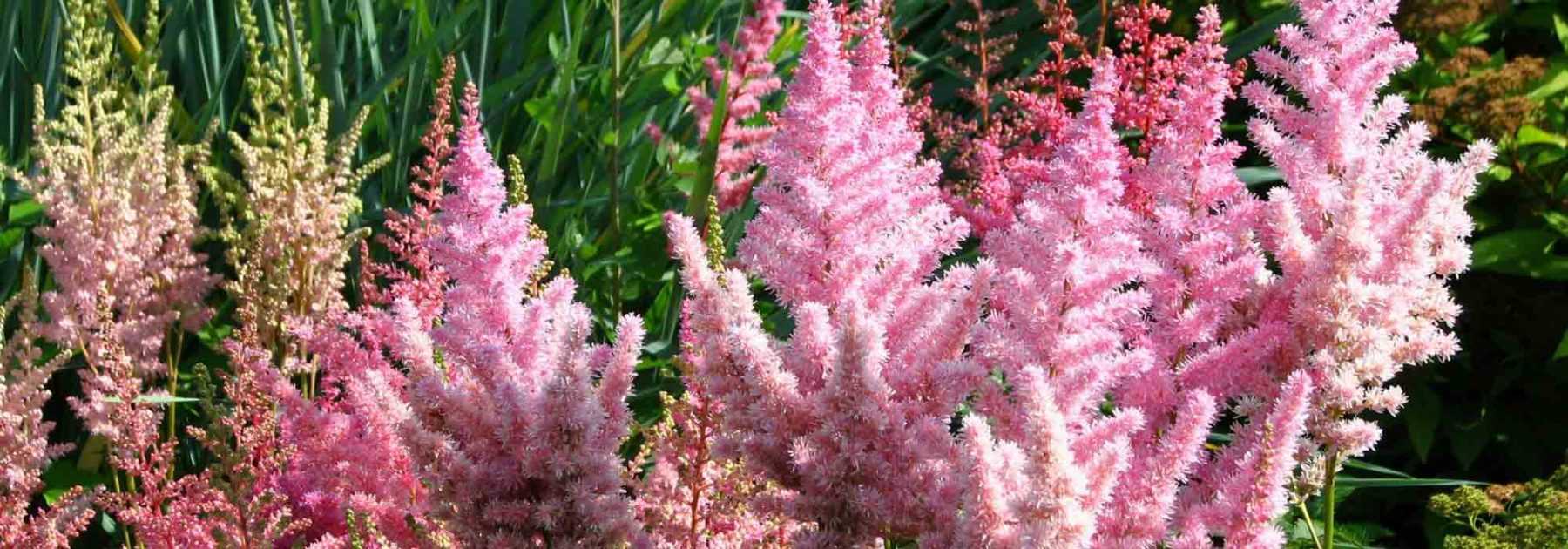
Astilbe: Planting, Growing and Care Guide
Contents
Astilbe in a few words
- Astilbe is the perfect perennial for brightening shady spots and water garden edges
- Its feathery plumes of colourful flowers bloom in early summer
- The vigorous foliage remains spectacular until autumn
- Hardy and easy to grow in rich soil, it requires consistently moist conditions
- It’s a signature plant for naturalistic gardens
Our expert's word
Astilbe is a herbaceous perennial with a lush, bushy habit, remarkable for the poetic charm of its ethereal blooms and delicate, finely cut foliage. Once unfairly overlooked but widely used in our grandmothers’ gardens, the graceful Astilbe has made a comeback in recent years, thanks to the introduction of new varieties.
From June to August, its airy inflorescences in long plumes of pink, white or red – some reaching over 1.50m tall – brighten up shady corners of the garden.
From early-flowering Astilbe japonica (Japanese Astilbe) to the hybrid Astilbe x arendsii with its numerous varieties, and the late-flowering Astilbe chinensis (July-August) which tolerates drier soils better than other species, all are exceptionally floriferous, even in shade.
It’s no coincidence that Astilbe grows wild in woodland edges near watercourses!
This moisture-loving perennial thrives in cool to heavy, marshy soils but also adapts to any good garden soil provided it doesn’t dry out in summer. Hardy (-20°C), disease-free and long-lived, it flourishes in shade or partial shade.
With its varied colours and low maintenance, it graces naturalistic gardens, waterside plantings, damp garden areas and part-shade borders, creating an evanescent mist beneath deciduous trees. It even suits rock gardens and large cool containers.
Cut Astilbe inflorescences make charming fresh or dried bouquets with a rustic appeal.
Romantic or fiery, ethereal – from pink to red Astilbe – discover this beautiful, easy-going perennial, indispensable for pond edges and moist soils!
Description and botany
Botanical data
- Latin name Astilbe
- Family Saxifragaceae
- Common name Astilbe
- Flowering from June to August
- Height 0.20 to 1.70 m
- Exposure sun, Partial shade
- Soil type Heather (Acidic), Neutral
- Hardiness -20° C
Astilbe is a rhizomatous perennial plant belonging to the Saxifragaceae family, like heucheras and bergenias. The Astilbe genus includes around a dozen species native to moist environments, woodlands, and riverbanks in the mountains of Southeast Asia and North America.
It’s not uncommon to find large wild astilbes growing along ditches or near damp areas.
Most astilbes cultivated in our gardens are horticultural hybrids created by crossbreeding different species; Astilbe x arendsii, A. davidii, A. chinensis, A. japonica, A. thunbergii, A. simplicifolia. Typically classified into these groups, they can vary considerably in size, shape, colour, and flowering period.
Depending on the species, plant height ranges from 20 cm to 1.70 m when in bloom. This perennial spreads easily through its surface-growing rhizomes. In spring, Astilbe displays a graceful, bushy, upright clumping habit, more or less airy or dense.
Somewhat slow to establish, Astilbe takes two to five years to reach full maturity and form a beautiful, regular clump. Once well-rooted, this rhizomatous perennial grows rapidly to form dense clumps.
A long-lived plant, once properly settled, astilbe can thrive for many decades.
Graceful astilbe is particularly prized in gardens for its inflorescences – long, romantic, and airy plumes. From June through August, depending on the variety, highly colourful, feathery panicles, 20 to 50 cm long in the largest cultivars, composed of tiny flowers, rise above the foliage.


From left to right: young coppery foliage in spring / inflorescences ready to bloom / flowering panicles / faded inflorescences, still decorative in winter.
Lilac-pink, pure white, creamy white tinged with pink, pale pink, violet-pink, magenta, deep purple, or intense red – depending on the variety – they appear to float in mid-air, suspended from their slender peduncles.
While these colourful plumes are usually upright and sometimes compact (Astilbe chinensis ‘Pumila’), they can be pendulous in certain varieties (Astilbe thunbergii ‘Straussenfeder’) or slightly arched, rivalling goat’s beard (Aruncus dioicus). The flowering period lasts 2 to 4 weeks. Fragrance isn’t astilbe’s primary characteristic, though some species like Astilbe simplicifolia ‘Pink Lightning’ emit a delicate scent.
The airy spikes dry in shades of brown and remain highly decorative throughout winter. They’re perfect for creating large bouquets of ephemeral fresh flowers (they wilt quickly) or dried arrangements.
The vigorous, spectacular foliage provides a perfect setting for the airy inflorescences. Deciduous, the foliage disappears in winter and only reappears in spring. As it spreads, it lends the plant a certain opulence. Exceptionally elegant and finely divided, it evokes the lightness of certain ferns.
The leaves, 15 to 75 cm long, oval to pointed, are deeply lobed, divided into numerous toothed leaflets. Medium to dark glossy green in most varieties, they’re sometimes tinged with red or variegated with green and burgundy red (Astilbe ‘Colour Flash’) and can develop magnificent autumn hues. Astilbe ‘Chocolate Shogun’, a new variety, produces near-black chocolate foliage.
Astilbe maintains beautiful foliage until the first frosts.
This lovely perennial thrives in cool, shady woodland settings which it brings to life. It’s essential for moist, marshy soils.
Easy to grow, it prefers rich, deep, consistently moist and fertile soil, preferably slightly acidic, in partial shade or under non-scorching sun. Some hybrids are less demanding regarding water than other species and better suited to ordinary soil.
It’s the perfect plant for planting in woodland under deciduous trees, beside ponds, and of course in flower beds, borders, or at the back of borders for taller specimens.
Dwarf species are best suited to cool rock gardens or container cultivation.
Main species and varieties
There are nearly fifteen species, including many hybrids and some particularly interesting cultivars, allowing for varied heights (Astilbes range from 20 cm to over 1.70 m tall), colour variations (white, pink, or red), different forms (more or less compact), and flowering periods.
Astilbe x arendsii is a hybrid available in numerous varieties (‘Bressingham Beauty’, ‘Fanal’), while Astilbe chinensis is known for its ground-covering variety ‘Pumila’. Astilbe japonica stands out for its red varieties (‘Red Sentinel’, ‘Montgomery’), and Astilbe thunbergii ‘Straussenfeder’ (meaning “ostrich feather” in German) is a hybrid with large, drooping, feathery panicles.
The Astilbe chinensis ‘Vision’ series differs from other astilbes as it forms a group of recent hybrids selected for their vigour and moderate water requirements, thriving in ordinary soil that doesn’t dry out completely.
While Astilbe x arendsii hybrids are the most common, discover our selection of the finest astilbes, chosen for their exceptional blooms, rarity, or uniqueness.
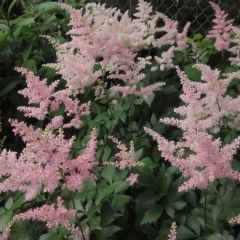
Astilbe japonica 'Peach Blossom'
- Flowering time August, September
- Height at maturity 70 cm
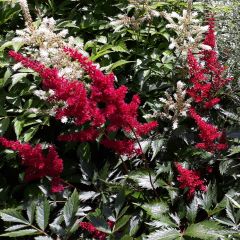
Astilbe Montgomery
- Flowering time August, September
- Height at maturity 60 cm
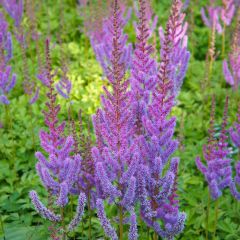
Astilbe chinensis Pumila
- Flowering time August to October
- Height at maturity 30 cm

Astilbe thunbergii 'Straussenfeder'
- Flowering time August, September
- Height at maturity 1 m
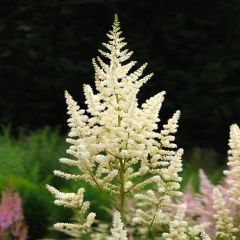
Astilbe Deutschland
- Flowering time July, August
- Height at maturity 50 cm
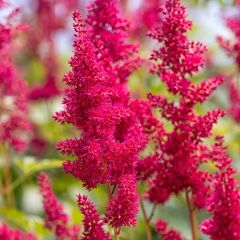
Astilbe Fanal
- Flowering time July, August
- Height at maturity 60 cm
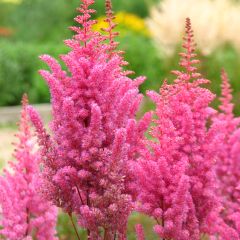
Astilbe chinensis 'Veronica Klose'
- Flowering time September, October
- Height at maturity 40 cm
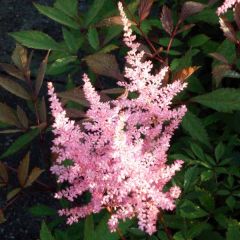
Astilbe arendsii Erika
- Flowering time August, September
- Height at maturity 80 cm

Astilbe Color Flash
- Flowering time July, August
- Height at maturity 60 cm
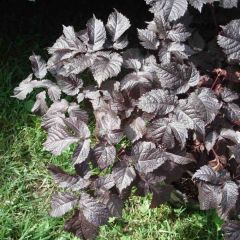
Astilbe 'Chocolate Shogun'
- Flowering time July, August
- Height at maturity 50 cm
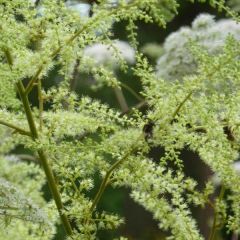
Astilbe rivularis Grandiflora
- Flowering time August, September
- Height at maturity 1,70 m

Astilbe chinensis Vision in Pink
- Flowering time July to September
- Height at maturity 60 cm
Discover other Astilbe - False Goatsbeard
Planting
Where to Plant Astilbe?
Hardy down to -20°C, Astilbe thrives almost everywhere in France, except in Mediterranean climates, which are too dry and hot in summer: its only requirement is moist soil in summer and cool conditions in other seasons. Conversely, astilbe dislikes waterlogged conditions in winter, so avoid planting it in areas prone to prolonged flooding during winter months. It can tolerate summer heat in temperate regions, provided the soil remains consistently moist and cool.
Astilbe flourishes in partial shade, sheltered from scorching sun, beneath the canopy of deciduous trees that provide beneficial coolness. It enjoys bright locations but without direct sunlight during the hottest hours.
Very easy to grow, it nevertheless requires soil rich in organic matter and good drainage to bloom well. It adapts to all soil types except chalky, poor, dry, or stony soils, where it will never thrive.
It typically prefers woodland soil, neutral or acidic, essential for healthy growth. You can plant it at the heart of a heather bed.
It favours heavy, clay soils kept sufficiently moist with a good mulch during the growing season. Cool soil allows it to develop vigorously.
While it suits all garden styles, this perennial truly shines as a woodland plant, by damp banks, or in marshy garden areas, where its luminous blooms will brighten the space. It adds an airy texture and striking impact in the foreground or middle of borders.
When to Plant Astilbe?
Plant Astilbe in spring from February to April after frosts or in autumn from September to October, once intense heat has passed.
How to Plant Astilbe
In the ground
Plant 3 to 5 specimens per m² of different varieties, spaced at least 30 to 50 cm apart to allow proper growth. For a striking effect in borders, opt for planting in small groups. It’s an ideal perennial for creating an astilbe border.
- Dig a hole 2 to 3 times wider than the root ball
- In poor soil, add well-rotted compost to the base of the hole before placing the root ball
- Backfill soil around the roots
- Firm down and water thoroughly until established, especially in the first year
- Keep the soil cool at the base with organic mulch (such as hemp), particularly in summer—this ensures prolonged flowering
Planting Astilbe in Pots
Plant Astilbe in a large container with a mix of potting soil and consistently moist compost. First, add a generous layer of drainage material (gravel or clay pebbles) to the pot’s base. Mulch and water very regularly, never letting the growing medium dry out. Fertilise regularly with organic feed during the flowering period.
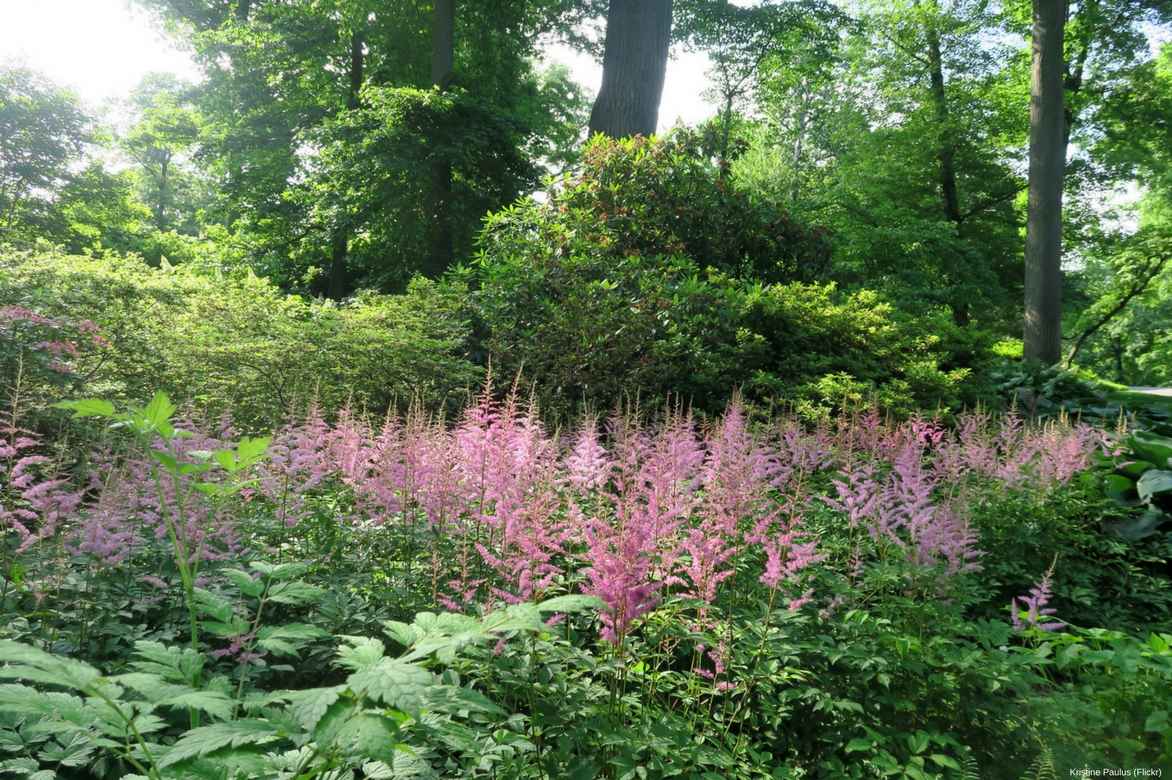
Maintenance, Pruning and Care
This is a hardy perennial that’s hungry for nutrients and loves water. Coolness and soil moisture are the keys to success! Astilbe proves to be a trouble-free, beautiful perennial – provided the soil remains cool and sufficiently nourishing.
Chinese Astilbes tolerate dry soils and drought periods better than most species. For others: the soil must be kept sufficiently moist in summer, or they may quickly wither in drought conditions.
- Apply a good organic mulch around the base to reduce evaporation
- Water daily during heatwaves, but avoid waterlogging
- Astilbes are heavy feeders: fertilise annually in March with compost (about 5 cm thick) to improve winter drainage and encourage root development
- Every 2–3 years, in late winter, spread a few spadefuls of compost around the base to cover roots exposed by watering
- Deadhead spent flowers after blooming to promote better foliage growth, or leave them to dry on the plant for winter interest
Diseases and potential pests
Hardy, the Astilbe is an easy-to-grow plant that resists insects and diseases.
Its only concern is powdery mildew, a fungus recognisable by the white felting it leaves on the foliage. Spray Bordeaux mixture as a preventive measure, along with nettle and horsetail manure. Do not leave any residues of diseased plants on the ground; burn them.
The flower buds may be susceptible to late spring frosts.
In case of water shortage, brown spots may appear on the foliage.
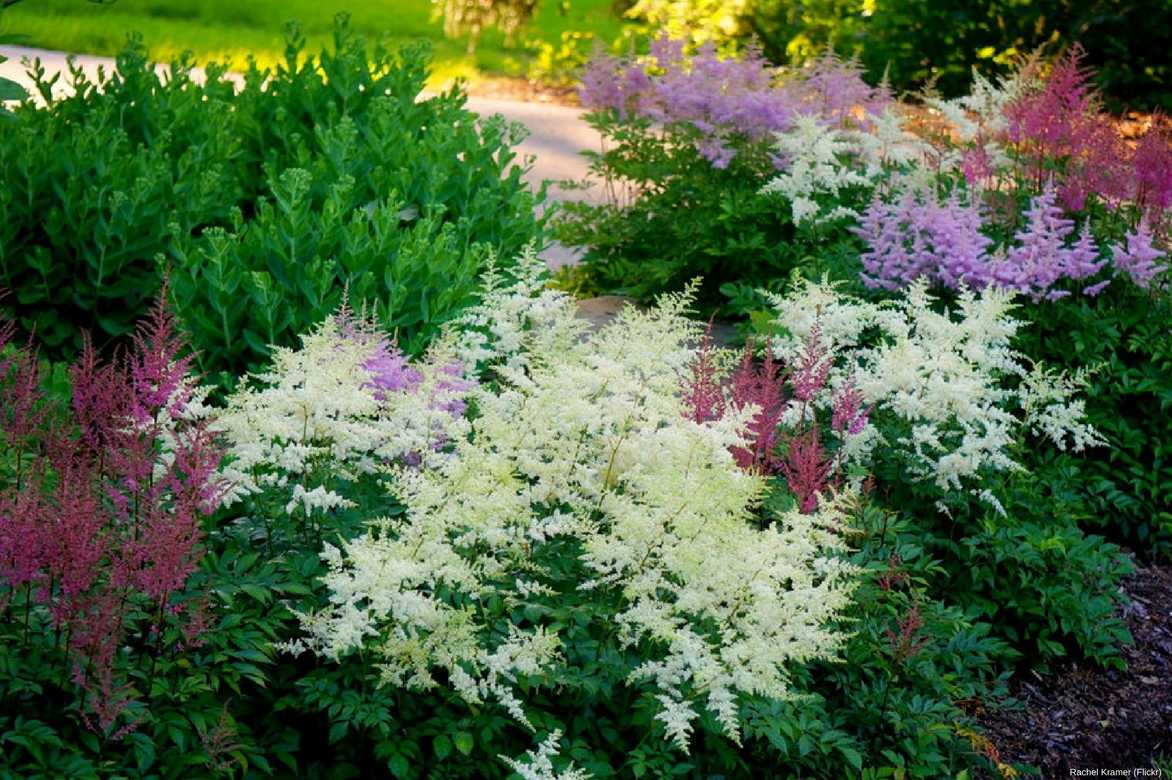
Propagation
Astilbe can be easily propagated by dividing the clumps. After 4-5 years, when the plant is well established, from December to March, divide the most substantial clumps to rejuvenate the plant and maintain beautiful blooms. Ideally, divide the rhizomes every 4 years, as over time the centre of the clump tends to weaken and become less floriferous.
- Using a garden fork, dig up part of the clump before the leaves reappear
- With a spade, slice off a healthy section of the clump
- Replant the divisions immediately in well-prepared garden soil or pot them up to plant out the following June, once they have properly recovered.
Combining Astilbe in the Garden
A staple of shade gardens and bog gardens, Astilbe is perfect for brightening cool areas, playing with subtle hues and gradients, and quickly establishing an elegant and refined atmosphere. Following spring blooms, it takes over before the abundance of summer flowers.
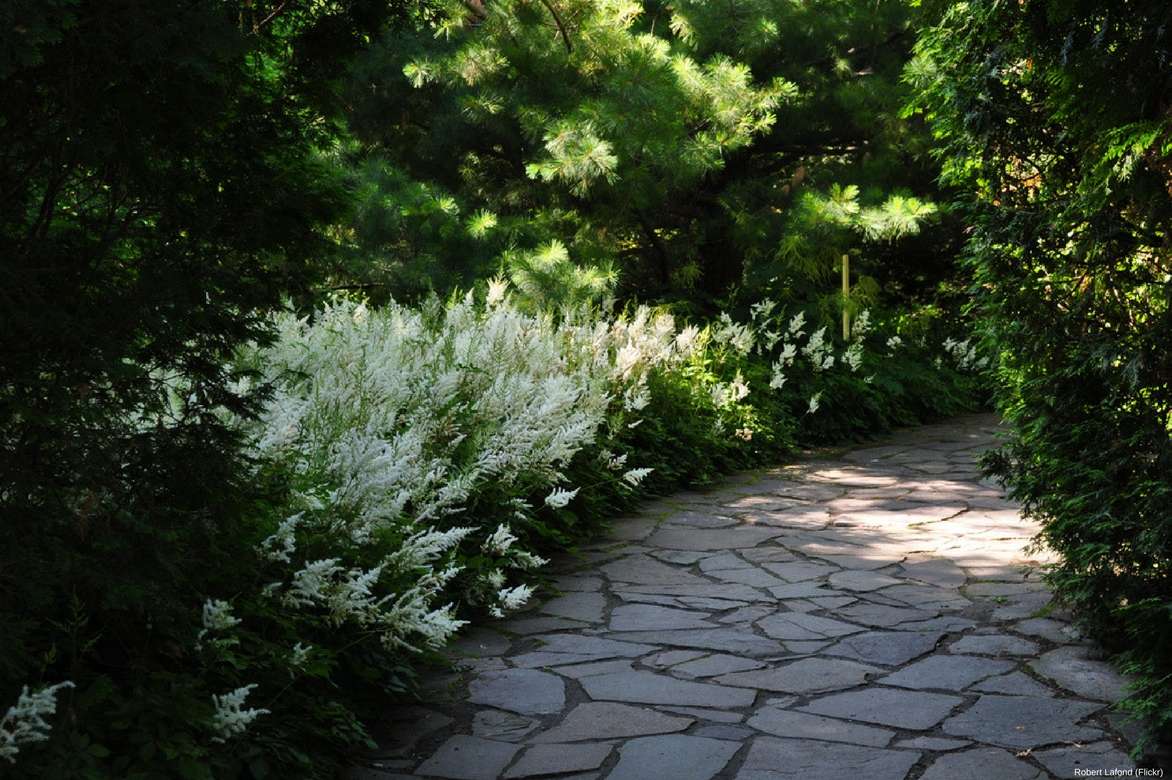
Astilbes light up shaded pathways.
With its feathery silhouette, delicate foliage, and pastel or fiery crimson inflorescences, it transforms a simple border or damp flowerbed into a poetic or vibrant scene.
Whether towering over 1m tall or forming a ground cover, it fits seamlessly into any shaded setting, dazzling as a mid-border plant creating an ethereal mist or as a mossy floral carpet for cool rockeries.
It adds charm to soft, countryside-style gardens or meadow-inspired designs, bringing breath, exuberance, and lightness. It’s a must-have for pink gardens, alongside Japanese anemones.

A natural pairing idea: Astilbe ‘Diamant’ alongside roses ‘Prieuré de St Cosme’ and ‘Colette’, with a Cornus kousa ‘Wieting Select’ in the background / Le jardin sainte Anne.
Planted in ribbons along pond edges or banks, it pairs beautifully with damp-loving perennials such as water irises, marsh marigolds, Goat’s Beard, rodgersias, comfreys, Meadowsweet (Filipendula), loosestrifes, and knotweeds…
It creates a lovely contrast when paired with less flexible plants like Hostas or ferns, its shade-loving companions. It works wonders with heathland shrubs like Hydrangeas, which provide gentle shade without overshadowing it.
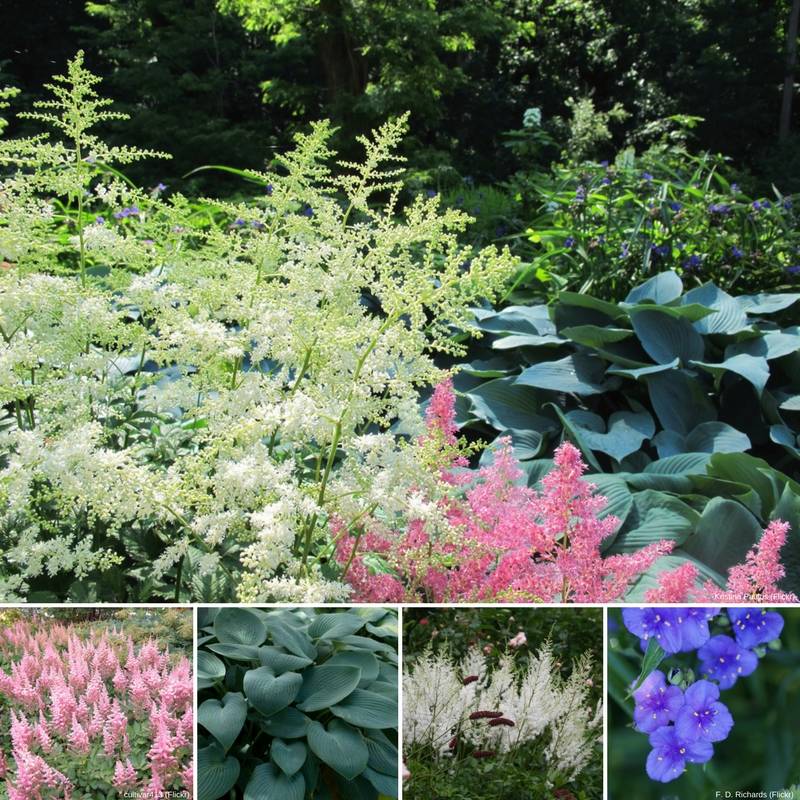
A woodland understory example: Astilbe chinensis ‘Vision in Pink’ / Hosta tardiana ‘Halcyon’ / Astilbe arendsii ‘Diamant’ / Tradescantia andersoniana.
Among its favourites are also large sedges, ornamental grasses, and bamboos.
In a vividly coloured waterside setting, Astilbe ‘Red Sentinel’ will stand out against the yellow-green foliage of a Cornus ‘Aurea’ and make a striking partner for euphorbias and ligularias.
In a wild garden border or mid-bed, the upright pink panicles (Astilbe ‘Bumalda’) or white (Astilbe japonica ‘Deutschland’) will harmonise beautifully with the mauve, lilac, lavender, and violet tones of loosestrifes, contrasting with the orange of a crocosmia and the yellow of daylilies.

A final pairing idea: white astilbes like ‘Snowdrift’ or ‘Avalanche’ pair wonderfully with the white bark of birch trees like Betula utilis ‘Jacquemontii’ / Astilbe chinensis ‘Pumila’ complements the purple foliage of Acer palmatum ‘Atropurpureum’.
To keep its base cool, consider ground covers like sweet woodruff, heucheras, or bugleweed.
→ Discover more Astilbe pairing ideas in our guide!
Useful resources
- Discover our superb Astilbe collection, featuring over 30 varieties
- Our advice sheet: Choosing an Astilbe
- Explore other comfort plants in our advice sheet
- Subscribe!
- Contents





































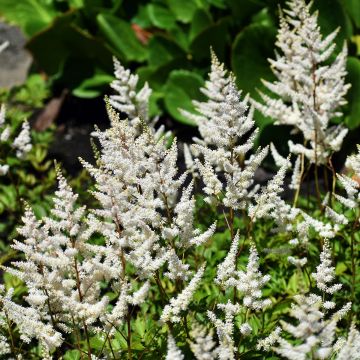

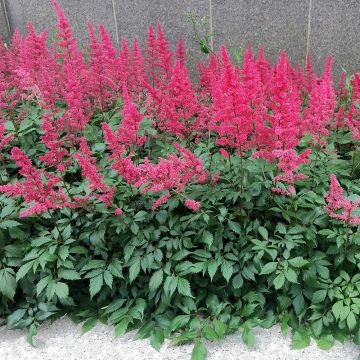
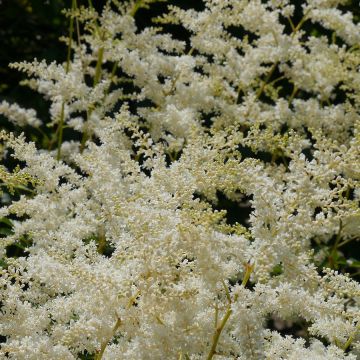
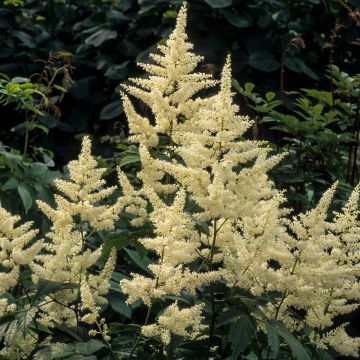
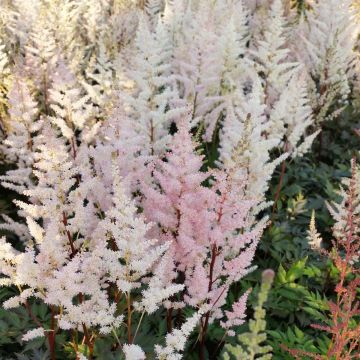
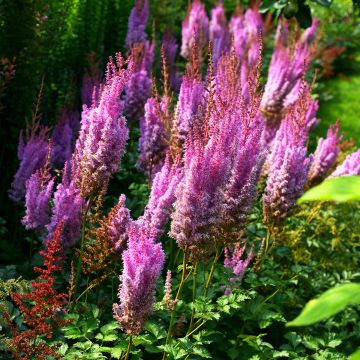
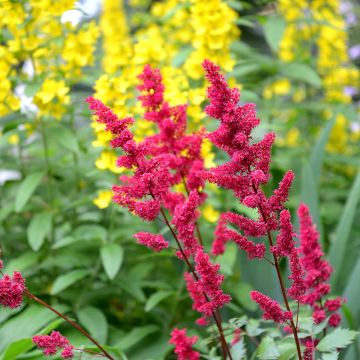


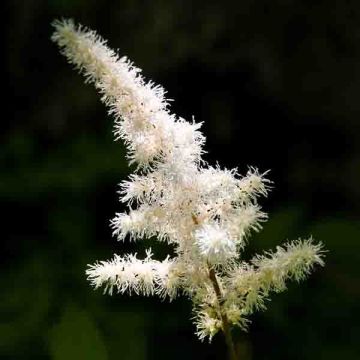


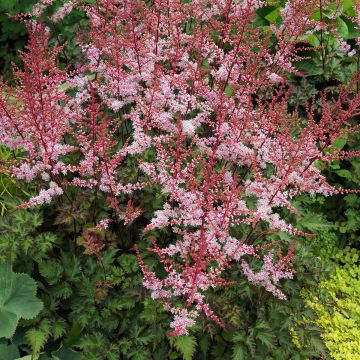
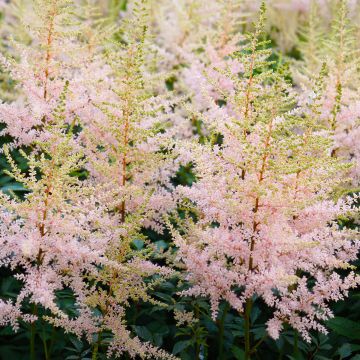
Comments